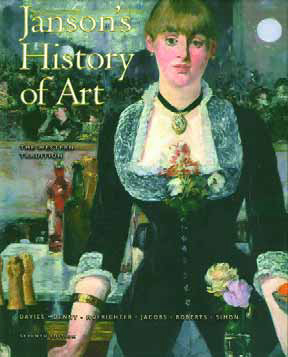A Place to Begin

It’s a bit hard for me to believe it, but it’s now been fully 11 years since I attended my first Genesis 3 design school. One of the events I remember most clearly from that first session was (among many others) David Tisherman laying out a bunch of books and recommending that we should immediately obtain and read all of them.
Always looking for a firm foothold, I asked him which one I should read first, and, without hesitation, he pointed to Janson’s History of Art: The Western Tradition. I didn’t act on his advice right away, but I eventually acquired a copy and started reading – and it took me nearly two years to get through its 1,100 oversized pages.
The book is the work of six eminent art historians – Penelope J.E. Davies, Walter B. Denny, Frima Fox Hofrichter, Joseph F. Jacobs, Ann M. Roberts and David L. Simon – and has been reprinted several times. The edition I own was published in 2007 by Pearson’s Education, Inc. (It’s widely used as a college textbook, so second-hand copies are readily available.)
A decade ago, I was in many ways just beginning my journey into the world of art and architecture: I had previously earned my degree in landscape architecture and had stepped into the workplace with the word “designer” stamped on my forehead, but the truth is, I’d finished school not knowing much at all about the history of art. In reading this book at long last, I was stunned to see how much was involved in the entirety of the Western design tradition, from antiquity to modern times – and everything was new to me.
There are lots of ways to interpret this extreme form of revelation and define the importance of putting what we do in a grander context. Since completing the book, I’ve been most impressed to hear others say that art history constitutes a shared language designers use to communicate clearly and effectively with educated clients.
On a more practical level, I am aware that those who have embraced design education and have thus been able to focus their energies on custom work are holding up pretty well in our flat economy, while those who still treat pools as mass-produced commodities are either in serious trouble or completely out of the business. In that sense, art history can also be seen as spelling the difference between success and failure.
In essence, I have the sense that by embracing the grand, rich narratives of our creative past, we can all become energized by this expansive world of ideas and approach our work with greater enthusiasm and spirit. It even fuels a desire to travel and get out to see the world’s beauty with our own eyes. In a very real way, in other words, reading this book has made my life more enjoyable and, personally, my work more dynamic.
I came full circle on this path last November, when I took Genesis 3’s art history course and discovered that the instructor – my fellow WaterShapes columnist Mark Holden – uses Janson’s as its centerpiece. And I wasn’t the least bit disappointed, because when everything was explained through the perspective of such a talented designer and teacher, I found the book taking on new meanings and even greater significance for me.
To sum it all up, this volume is truly the place to begin your grandest creative journeys.
Mike Farley is a landscape architect with more than 20 years of experience and is currently a designer/project manager for Claffey Pools in Southlake, Texas. A graduate of Genesis 3’s Level I Design School, he holds a degree in landscape architecture from Texas Tech University and has worked as a watershaper in both California and Texas.










